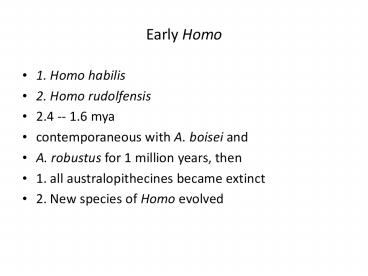Early Homo - PowerPoint PPT Presentation
1 / 21
Title:
Early Homo
Description:
Alternation of warm and cold climates. With glacial advances ... Occipital 'bun' Reduction in relative tooth size 'Turkana boy' Kenya, Africa. 1.6 mya ... – PowerPoint PPT presentation
Number of Views:66
Avg rating:3.0/5.0
Title: Early Homo
1
Early Homo
- 1. Homo habilis
- 2. Homo rudolfensis
- 2.4 -- 1.6 mya
- contemporaneous with A. boisei and
- A. robustus for 1 million years, then
- 1. all australopithecines became extinct
- 2. New species of Homo evolved
2
(No Transcript)
3
(No Transcript)
4
Homo erectus
- Fossils 1.8 mya -- 300,000 Africa (1.7 in Asia)
- Pleistocene
- Alternation of warm and cold climates
- With glacial advances - lowering of sea level -
- land bridges
- Facilitated dispersal of Homo out of Africa
5
Differences in brain size and skull
characteristics
- Cranial capacity
- early Homo species (500 - 800 cc)
- Homo erectus (750 - 1,250 cc), averaging about
900 cc - Skull was thick
- Large, solid brow ridges
- Occipital bun
- Reduction in relative tooth size
6
(No Transcript)
7
Homo erectus
Turkana boy
Kenya, Africa 1.6 mya c. 12 years old 56
tall would have been 6 had he survived
to maturity
8
800,000-400,000 yBP Europe
Fossil sites for Homo erectus
9
Regional variation
10
A basic tool of Homo erectus Acheulian
biface hand axe
1.4 mya - 400,000 ya entire stone
flaked Acheulian technique
controlled use of fire
11
Early Homo sapiens
- Classification complex unresolved
- Archaic H. sapiens appears c. 350,000 yBP
- Found throughout the Old World (except far north)
- Brow ridges still prominent - but less dense
- Later forms have higher cranial vault and reduced
tooth size. - Mean cranial capacity increased to 1,410 cc in
Neandertals but. . .greater body mass
12
archaic Homo sapiens sites
13
early Homo sapiens showing erectus-like features
Petralona, Greece Bodo, Ethiopia
Dali, China
Oldest 500,000 yr, Bodo, Ethiopia heidelbergensi
s 700,000 yr.
14
Neandertals archaic Homo
- Lived in a time-range 130,000 - 24,000 ya
- Shared Europe with modern H. sapiens for c.
12,000 yrs. - Brain was, on average, larger than that of modern
humans 1410 vs. 1350 cc - Height 4.9 - 5.6 ft.
- Weight 110 - 143 lb.
- Heavier bones, more muscular
- Short extremities reduction of surface area
adaptation for cold climates? - Intentionally buried their dead.
- Homo neanderthalensis (DNA evidence)
15
Neandertal vs. modern human Skull shape may hinge
on one bone
Sphenoid bone (20-30 shorter)
Contacts 17 of the 22 bones
16
Neandertal sites Note not in Africa
17
Origin of modern Homo sapiens
Two competing hypotheses 1. Regional
continuity model
18
- 2. African replacement model
19
53 individuals complete sequence of mtDNA
Common ancestor of all modern mtDNAs lived in
Africa
B
- Most recent common
- ancestor of all modern mtDNA
- Most recent common
- ancestor of Africans and
- non-Africans
A
20
Phylogeny of 14 populations based on allele
frequenciesat 30 microsatellite loci and genetic
distances
- Geographically neighboring populations cluster
together - Basal branch separates African and non-African
groups - Split estimated from this data 75,000 to
287,000 ya - Consistent with African Replacement Model
Bowcock, Ruiz-Linares, Tomfohrde, Minch, Kidd,
and Cavalli-Sforza (1994)
21
- Genetic diversity at a single locus in chromosome
12 among people of 7 geographic regions 12
different alleles of TTTTC repeat - Each graph shows the frequencies of the various
alleles for a sample from a particular region. - Arranged by travel distance from sub-Sahara
Africa north. - If non-African populations were founded
sequentially by small bands of people migrating
from one population to the next, then non-African
populations should show a pattern of reduced
genetic diversity. - Conclusions
- 1. African populations show much greater allelic
diversity than non-African populations - 2. Consistent with African replacement model.































